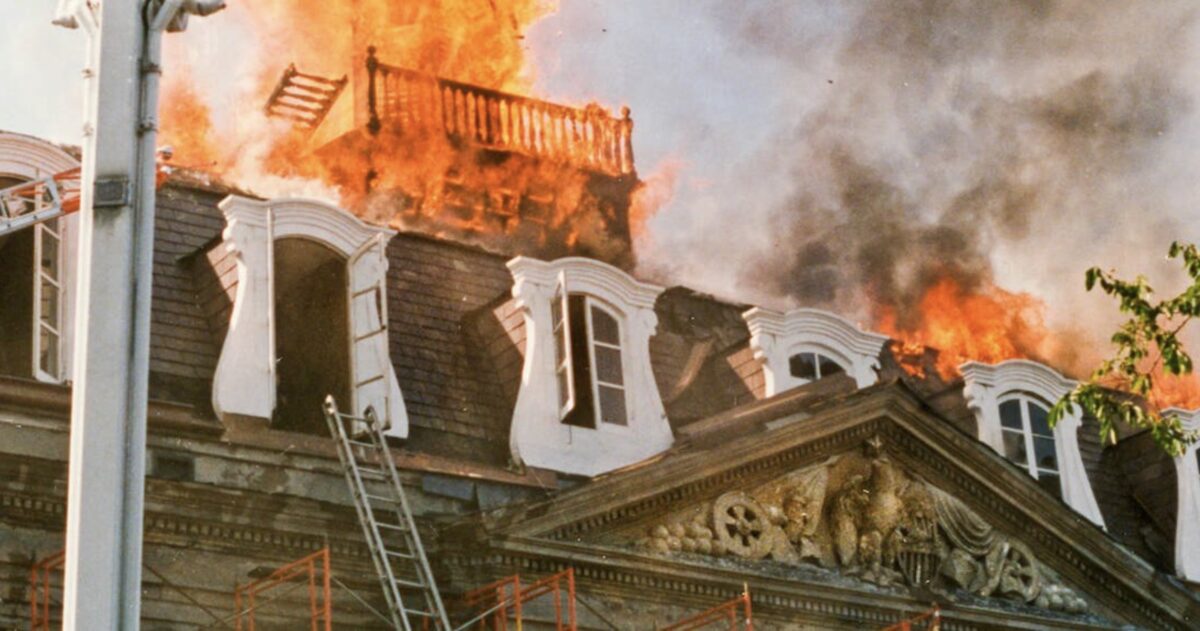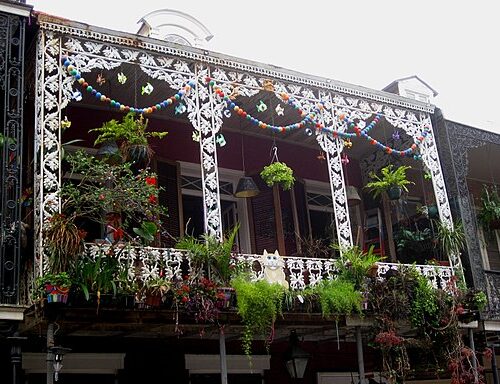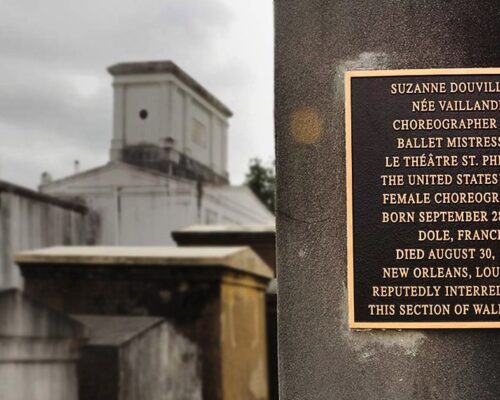Fire is the mortal enemy of the city’s oldest neighborhood, but in the case of the 1988 Cabildo inferno, dedicated preservationists prevailed in the end.
Originally published October 2019 in The French Quarter Journal.
“I thought it was a joke when they called me.”
Robert Cangelosi was in his office at the architectural firm Koch & Wilson when he received a phone call. It was May 12, 1988. And the Cabildo was engulfed in flames.
“They called me, and I was president of the Friends of the Cabildo. At first, it was like, ‘Ha, ha, ha! What’s the joke?’ I picked up my vice president, who lived nearby, and we drove down there immediately.”

Fire trucks were already on the scene at Jackson Square and more arrived each moment, reporting from surrounding communities. They pumped 10,000 gallons of water per minute onto burning timbers where there had once been a two-century-old mansard roof. Flames erupted through a ruined cupola, driven by the updraft.
Residents and tourists watched together from the street and through windows and rooftops, expecting the blaze to jump to adjacent buildings at any moment. Some locals wept to see one of Jackson Square’s stately architectural anchors being devoured before their eyes.
Started by a Torch
A worker’s soldering torch reportedly sparked the fire, which smoldered unnoticed for some hours before breaking through the roof. As the flames raged, firefighters went inside to rescue some of the artifacts held by the state museum within the Cabildo. They covered display cases with thick tarpaulins to protect from the water, and then set up a sort of bucket brigade, to carry historic pieces out and over to the Presbytere. The bronze death mask of Napoleon, centerpiece of the museum, was found undamaged.
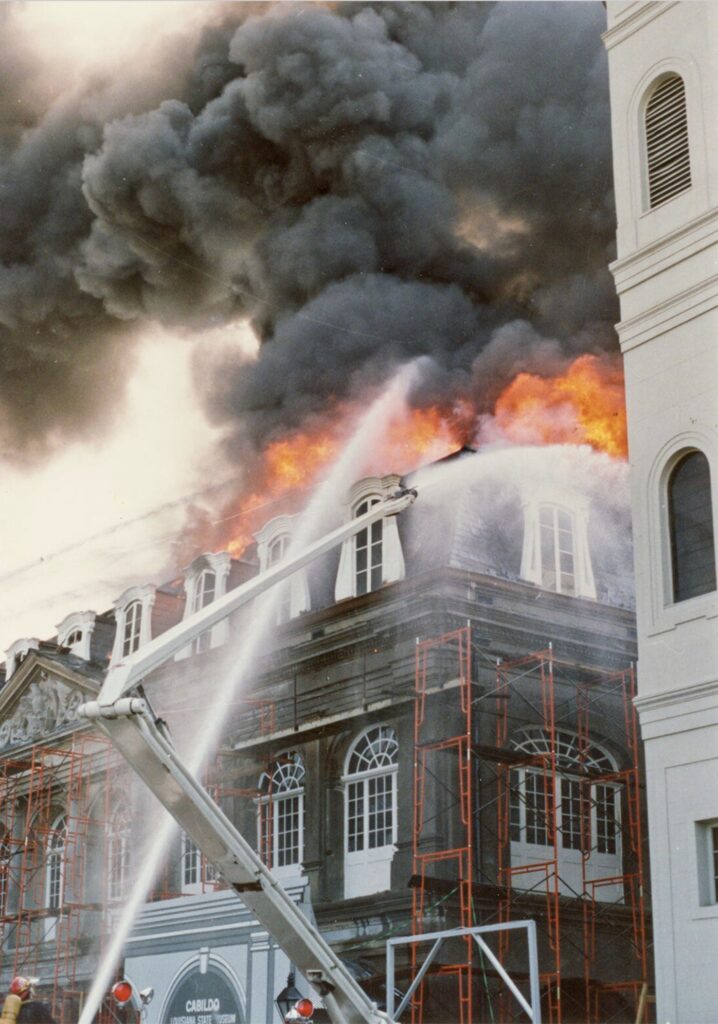
Later, a few volunteers were allowed inside to help rescue museum pieces and assess damage.
“It was like being under Niagara Falls, with the water coming down through the building there,” said Cangelosi. “You could barely see in front of your hand, with the amount of water that was coming through the building.”
By the next day, the fire was extinguished and the damage assessment began. The entire third floor was destroyed – the Sala Capitular, where the documents were signed to consummate the Louisiana Purchase, and where the Louisiana Supreme Court heard arguments in the landmark Plesy v. Ferguson court case. But surprisingly, the first two floors were spared the fire, and the overall structure was salvageable.
Restoration Effort
Work began immediately on assessments and plans for reconstruction. The building which had been slated for demolition in the early 1900s became the focus of a heroic restoration effort.

Federal funds were available, but with that came a requirement to rebuild according to modern standards – and that meant a steel frame. But the museum and the state, with support of then-Gov. Buddy Roemer, wanted to see it rebuilt with historically-appropriate materials and methods. That meant cypress timbers and custom-hewn mortise-and-tenon joints.
The scale of this project was daunting, and the request was to complete the construction on a short schedule. Cangelosi, named as the chief architect for the project, worked with consultants across the nation to find the materials and artisans. The LSU Forestry Department studied charred remnants to identify the wood species, and the UNO Geology Department examined the stone staircase.
Search for Cypress
Appropriate cypress was found near Orlando, Fla., and pine came from the forests near Hammond, La. “We brought in a consultant on historic French timber framing,” said Cangelosi. “Most of the people doing heavy timber framing in the United States were following an English method. This was done in the French method.” They used the Presbytere as a model because it had a roof of similar vintage.
Extensive architectural surveys had been performed on the Cabildo. “I was talking to the architect at Independence Hall,” said Cangelosi. “He was shocked when I talked to him, because I was telling him everything we had on the Sala Capitular, and he said, ‘My God, you know we have no clue what the space the Declaration of Independence was signed in looked like at the time it was done.’”
Iron and Stone
The structure of the roof could be rebuilt, but artisans skilled in other details had to be found also. Some craftspeople were sourced locally. Sculptor Roc Paul of Abita Springs, La., was hired to replace lost ironwork and stone relief. In preparation for his work, he inspected the burnt structure from a unique vantage point – the roof of Le Petit Theatre, across St. Peter Street from the Cabildo.

The upper floor of the theatre “was the creepiest place I ever had to go through in my life,” Paul said. “And then a couple of years later, I was watching a documentary on haunted places in New Orleans. That place is haunted. I had to go through the storage place up there.” Paul reproduced the details of decorative metalwork and stonework from original sketches.
Witness to Reconstruction
I was fortunate to see for myself some of the reconstruction work. On the morning of March 13, 1992, I passed in front of the barricaded Cabildo on my way to meet friends. Laid out on the slate surface of Chartres Street were individually cut pieces of cypress, like a giant Lego project. It was the frame of the new cupola, literally to cap off the rebuilt roof. I had a 35mm camera with me, and captured images of the scene.
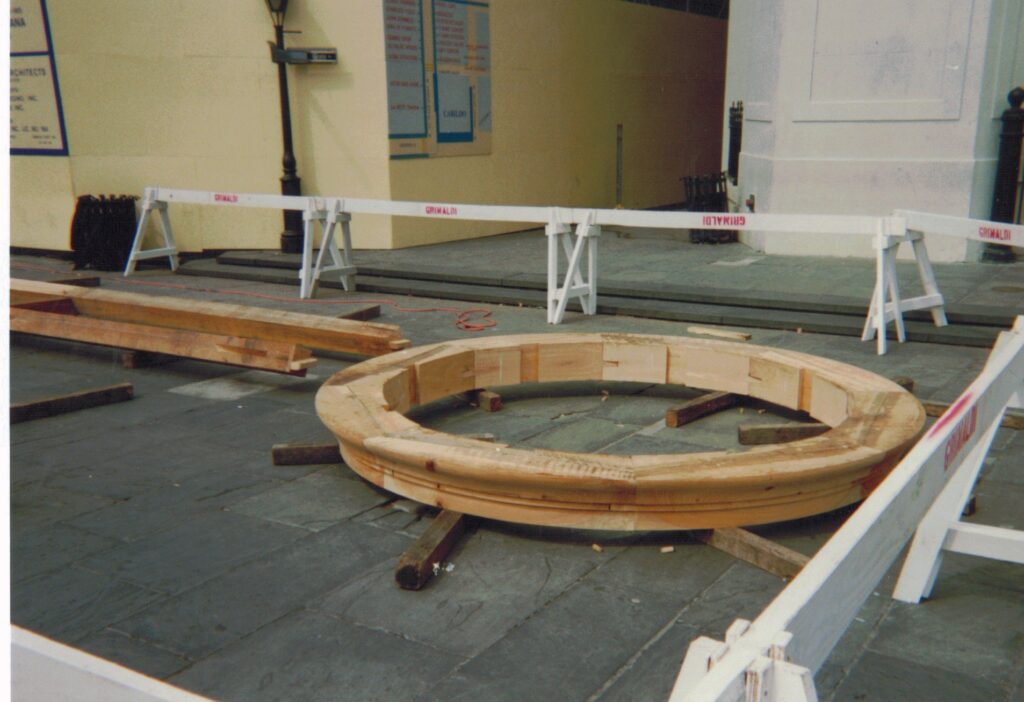
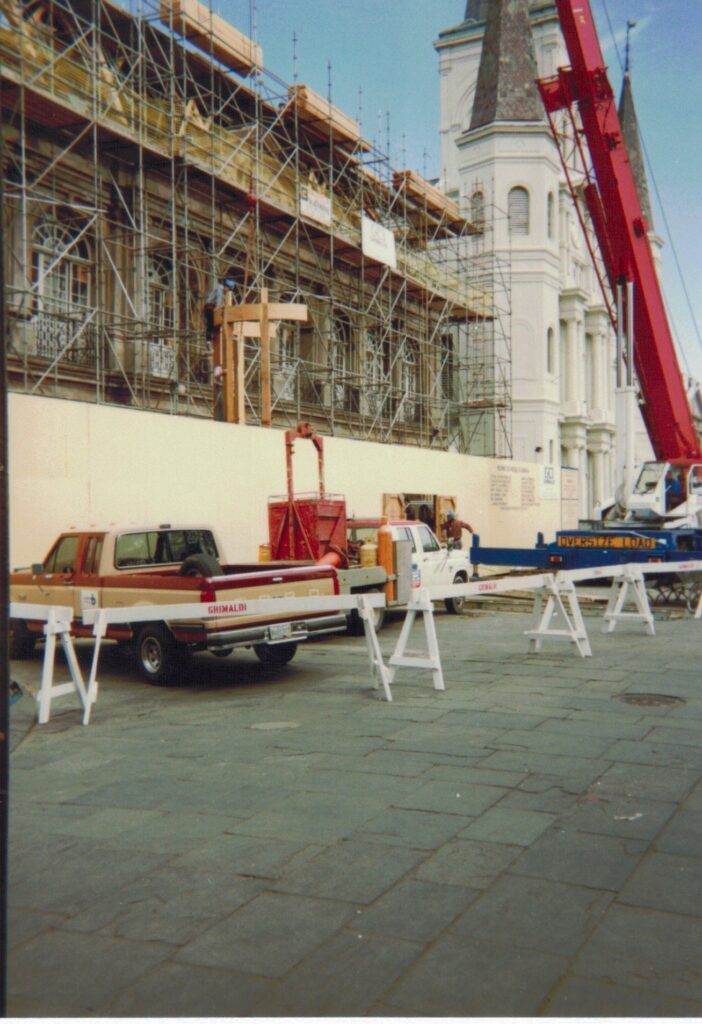
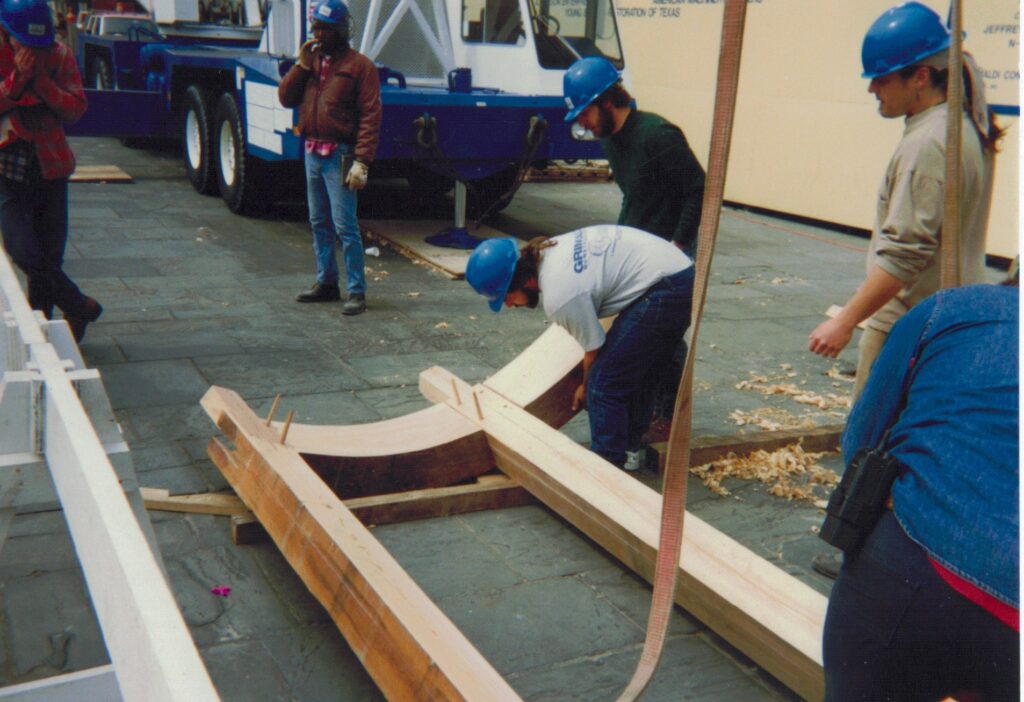
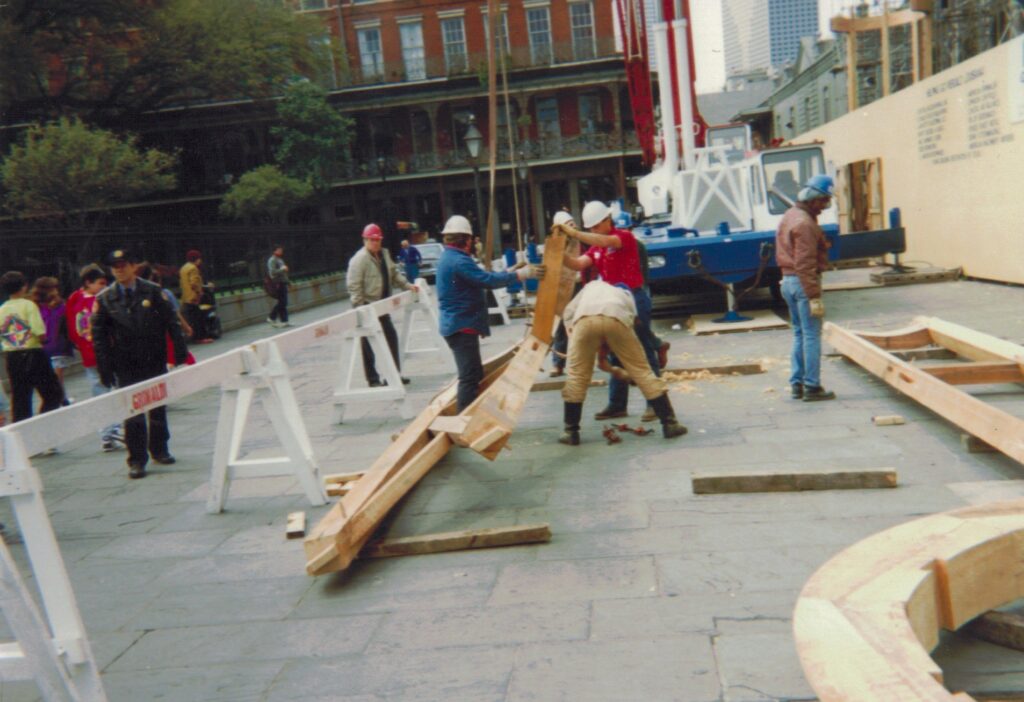


The puzzle parts included verticals and cross-members, and a circular cap, or tambour. Each cypress piece had been cut with care to fit together with mortise and tenon. The fitted parts were held together by oak pegs.

“The peg, which is oak, a harder wood, is driven on through,” said Cangelosi. “And as I said, it was done very, very authentically. We did do some cheating. We did use a crane to put them in place instead of using block and tackle.” Much of the assembly was performed in mid-air, with parts dangling from the crane.
It took considerable time and many more hours of work before the museum re-opened on Feb. 27, 1994. Former Gov. Edwin Edwards snipped the ribbon, commemorating the rebirth of a Vieux Carré landmark.
Work on the Cabildo continues. The fence around the arcade, called in the original documents, the portelis, was replaced after the main restoration. “There were problems with people urinating on it,” said Cangelosi. “And actually I found reports the mayors, going back to the 1840s, were complaining of guys urinating on what was there.”
Some things just don’t change.
